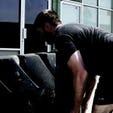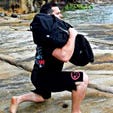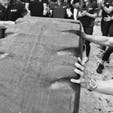Calisthenics, barbells, dumbbells, kettlebells, sandbags, tires and sleds; so many tools to make you a lean mean sculpted machine; also enough to cause so much confusion you don’t know where to start your program!
I am an advocate of keeping things very simple when it comes to training. First thing is to have at least one specific goal in mind. After a challenging, yet attainable goal is established, it’s time to create a training program.
The program should include the number of days you plan on training, the amount of volume or work you are going to do during those training days, and the exercises and equipment you are planning to use to help reach your goal.
Simplicity is king and variety is the spice of life. Establishing a simple plan does not mean that it has to be boring and consist solely of classic barbell, dumbbell, and bodyweight exercises. You can add some My Mad Method flavor with unconventional training tools to make your programs more exciting while also gaining strength much quicker.
I know firsthand how unconventional training tools can help with increasing strength. One area that lags in strength compared to my other movements is overhead pressing. I am always looking for ways to increase my pressing power and I have found that I would quickly plateau if all I did was the same exercises trying to lift more weight each week. It was not until I added different types of overhead exercises and started using unconventional tools that I began to see results in my overhead pressing strength. Putting weight overhead during each workout using a variety of movements and tools did the trick. Turkish Get Ups, high repetition water filled keg presses, and overhead kettlebell farmer walks were the answer for my lagging shoulders.
Why Incorporate Unconventional Training?
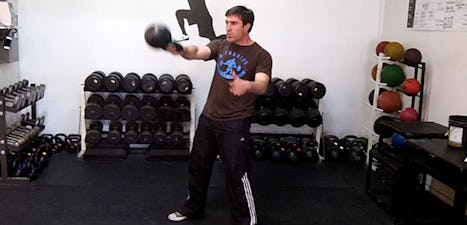 For the traditionalist and skeptic who does not feel the need to add unconventional training tools into their program to get stronger, there are a few unique traits unconventional tools possess that might just benefit your training more than you think. Here are a few benefits that unconventional training can provide:
For the traditionalist and skeptic who does not feel the need to add unconventional training tools into their program to get stronger, there are a few unique traits unconventional tools possess that might just benefit your training more than you think. Here are a few benefits that unconventional training can provide:
- Can help translate strength into power using tools like kettlebells swings and tire flips.
- Challenge joint and core stability more due to off-set weight distribution.
- Provide conditioning enhancement when incorporated during strength circuit sets.
- Stimulate muscles in different ways which is key for increasing strength and enhancing muscle growth.
- Are challenging and fun to break up the monotony of traditional training.
Whether you were completely on-board with unconventional tools or not, there is still the daunting task of adding these new options into your conventional strength and conditioning program. Worry not because I am about to show you how to plug these in and take your strength levels to new heights.
We are still going to keep our programming simple and keep our goals in mind; we just want to spice things up a bit. Before we get into programming, let’s go over a few unconventional tools and what they are primarily used for.
Kettlebell Training
Kettlebells are very versatile and their training effectiveness depends on how you use them. You can use them to increase your overall strength by lifting a heavy kettlebell during traditional strength movements like deadlifts and overhead presses. Kettlebells can be used to train power production by incorporating heavy swings and thrusters. You can also enhance your work capacity and strength endurance using kettlebells by simply changing the weight of the kettlebell and increasing the amount of time/reps you perform with those strength movements.
The kettlebell also adds some variety to traditional movements which can stimulate the body in different ways to achieve new levels of strength. One example is overhead pressing; take a kettlebell and flip it upside down and try a bottoms-up press. Even the strongest of pressers will be humbled the first time they try to put a moderately heavy weight overhead in this manner. Do you enjoy a dumbbell farmer walk stroll? Take two kettlebells and rack them up and go for a walk. Feel your chest compress and your breathing affected as you try to keep strength and posture under these conditions. When you can you will be stronger for it.
Sandbag Training
I use sandbags to train both power and stability primarily in a circuit style manner. Even heavily weighted sandbags are no match for heavy bar deadlifts and back squats when it comes to pure strength gains. The offset weight and its ability to shift during the movement bring out the beauty of this training tool. Someone who can back squat a 225lb bar may initially find trouble with their squat groove holding an 80lb sandbag in front of them. Muscles of the core really start to scream at you as you try and maintain proper alignment during the movement.
Sandbags are also excellent for power production. By coordinating your body to move an offset and shifting weight quickly from one point to another simulates the power needed to move an opponent in athletic competition. Movements such as sandbag shouldering, thrusters, and burpees are great ways to increase your repetitive power production ability.
Keg Training
Water filled kegs are not the most versatile unconventional training tool out there but I have found them to be one of the best when it comes to increasing overhead press strength and endurance. I have witnessed strong traditional overhead pressers humbled by a 70lb keg because they could not stabilize the weight overhead with the water sloshing around.
Incorporating sets of military presses and overhead farmer walks with the keg dramatically stimulates all of the stabilizing muscles of the shoulders which leads to increased strength in those muscles. When you go back to the classic military press after adding some keg training, your pressing strength should have increased.
Tractor Tire Training
If you have the space, adding tires to your training program provides a great opportunity to increase power production and endurance. Tire flips can be done for a few repetitions with a heavy tire or for many repetitions with a lighter one.
Tire sledgehammer training is one of my favorites because it is the opposite movement of hip-driven power production. Many other power exercises generate power from the legs to the arms, whereas tire sledgehammer work generates power from the arms to the legs. Balancing the body is a necessity; if you train one direction it is best to train the counter movement as well.
I also like tire training because you can use them for partner work. Whether you do tandem heavy tire flips or push the tire back and forth for upper body power production, partner training usually brings out the best in your training because you are responsible for doing your best to keep the flow of the training going.
There you have a brief overview of some unconventional training tools, now we have to program them. Below are some examples of ways I add these tools into my athletes’ training programs.
How to Add Unconventional Training into a Traditional Strength Program
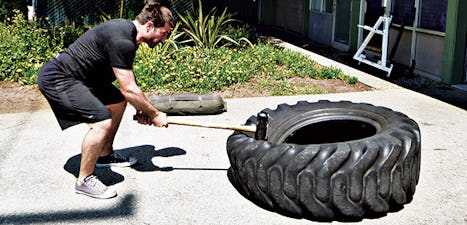 Unconventional training tools provide a great way to supplement a traditional strength exercise to help enhance your primary lifts. Below is a sample three-day-a-week training protocol incorporating some unconventional lifts around traditional strength training exercises.
Unconventional training tools provide a great way to supplement a traditional strength exercise to help enhance your primary lifts. Below is a sample three-day-a-week training protocol incorporating some unconventional lifts around traditional strength training exercises.
Strength Day #1
A: Deadlift – 5 x 5
B1: Dumbbel Step Up – 4 x 8-12
B2: Kettlebell Bottoms-Up Press – 4 x 3-5
C1: Dumbbell Row – 4 x 8-12
C2: Kettlebell Swings – 4 x 10-20
D1: Chin Ups – 4 x 3-5
D2: Tire Sledge – 4 x 10-20[/tab]
Strength Day #2
A: Bench Press – 5 x 5
B1: Double Kettlebell Racked Lunge – 4 x 8-12
B2: Kettlebell Renegade Rows – 4 x 5-10
C1: Dumbbell Pullovers – 4 x 8-12
C2: Sandbag Shouldering – 4 x 5-10
D1: Kettlebell Farmer Walk – 4 x Distance
D2: Kettlebell Get Up – 4 x 1-2
Strength Day #3
A: Squat 5 x 5
B1: Kettlebell 1-Leg RDL – 4 x 8-12
B2: Sandbag Bent Over Rows – 4 x 5-10
C1: Ring Push Ups – 4 x 8-20
C2: Sandbag Good Morning – 4 x 5-10
D1: Tire Flip – 4 x 5-10
D2: Keg Press – 4 x 5-10
One of my favorite ways to incorporate unconventional exercises is to use them in a conditioning circuit. Choose manageable weight, set a time and get after it. In this circuit each exercise should be done for 30-45 seconds, rest 15-20 seconds. Perform this whole circuit two to three times with a three minuets rest between rounds.
A1: Sandbag Shoulder (Alternating) – 3 x 30-45sec
A2: 2-Hand Kettlebell Swing– 3 x 30-45sec
A3: Alternating Kettlebell Press- 3 x 30-45sec
A4: Sandbag Zercher Squat- 3 x 30-45sec
A5: Tire Sledgehammer- 3 x 30-45sec
A6: Alternating Kettlebell Swing- 3 x 30-45sec
A7: Sandbag Clean & Press- 3 x 30-45sec
A8: Tire Flip- 3 x 30-45sec
Adding some unconventional training exercises into a carefully structured strength and conditioning program will enhance core strength, increase stability, and optimize power production. Besides the challenge, they are also very fun to do making your training much more enjoyable and rewarding. Now go out and make it happen!
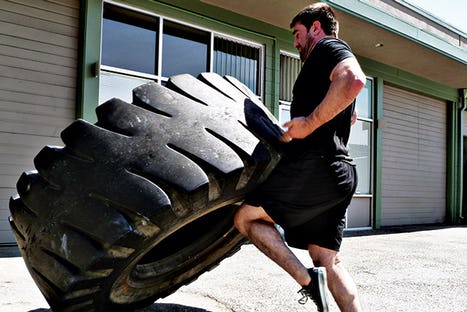
)
